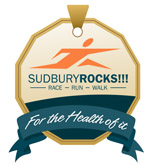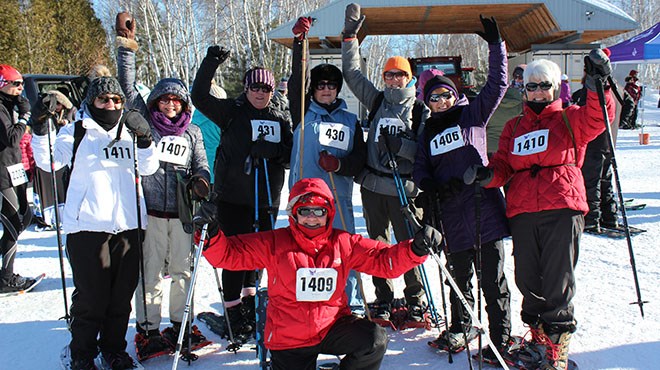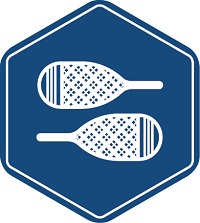Every Run Counts
There are no junk miles. If you're not injured so
badly that you're altering your form, or so sick that
you feel much worse after running, then it's all good.
Even if you think a run doesn't advance your fitness,
it has other benefits—promoting blood flow,
clearing your mind, getting you away from the computer,
burning calories, getting you out in nature, helping
you spend time with friends, maintaining the rhythm
of good training, and infinitely so on.
No Regrets
It's not uncommon to go to bed thinking,
“Darn, I should have run today.” But it's
not common to go to bed
thinking, “I shouldn't have run today.”
Just get up and go. We promise, you will likely never
regret it.
Secret Source of Energy
When you're feeling flat, a little fast running is
often the best cure. A slow 5 miles might leave you
feeling more lethargic. Instead, throw in some random,
short pick-ups, or do a set of striders on your street
once you've done your normal loop. Little bursts of
fast running can help you surpass sluggishness.
Variety is the Spice
of Life
Multi-pace training is, of course, the key to top
performance regardless of your target race distance.
But that's not the only reason to do all sorts of
workouts regularly, from long runs and basic speed
sessions to slow recovery runs and tempo workouts.
There’s no better way to keep your running interesting
than to have peaks and valleys of intensity and duration
woven throughout your training weeks.
Mini Workout Finishers
Not every “hard” workout has to be a killer
session. You can sneak in more quality without going
to the well by stopping at a track, on a hill, or
an obstacle-free stretch of road toward the end of
a run and doing a few up-tempo repeats between 200
and 800 meters.
Steal Workouts from
Elites
When you hear elites talk about their training, translate
their workouts into efforts relative to your own race
pace. A 20-miler with the last 8 miles at 5:00 per
mile sounds really fast, and it is. But it’s
really just a long run with the last portion at marathon
race pace. You can and should do such a workout before
your next marathon at your own paces.
Recovery Days
It’s also helpful to understand elites’
recovery paces relative to race paces. A national-class
woman who runs easy mileage at 7:30 per mile is doing
those recovery runs more than 2 minutes per mile slower
than her 10K race pace. That means you should add
at least 2 minutes to your 10K race pace for recovery
runs, even if it feels like you’re crawling.
It’s called a recovery run for a reason!
Fast Finishes
Finish some of your longer repeat workouts, like miles
or kilometers, with a few 200 or 300 meter sprints.
You’ll be pleasantly surprised at how fast you
can run the short segments once you’re fully
warmed up. You might even surprise yourself and set
a PR.
Go Watch-Free
At least a few times a month, decide what route you’re
going to run, and then leave your watch at home. Other
days, run wherever, guided by total time on your watch.
The thing to mostly avoid is timing yourself over
the same courses day after day. That way lies the
madness of beating yourself up for running slower
than you “should” or forcing yourself
to pick it up because you’re six seconds slower
at a checkpoint than you were yesterday. It’s
never good to be a slave to the numbers every time.
Cross-Training is Key
When you’re hurt and have to cross-train, try
to spend more time on it than you do your running.
After all, you can get in a decent run in 30 minutes,
but you’re not going to find a lot of cyclists
who would consider half an hour anything but a warm-up.
Make the time go faster on individual workouts by
translating your usual hard running workouts—VO2
max sessions, tempo workouts, etc.— to the pool
or bike or elliptical or wherever you’re spending
your non-running time. Structure cross-training weeks
like your running weeks; the variety will help your
time in injury limbo pass faster than if you do the
same medium-effort waiting-out-the-clock workout every
day.
Escape Ruts
When you feel like you’re in a rut, make a deliberate
effort to shake things up. Head out the door without
the slightest plan of where to run. Run at an unusual
time of day. Drive to run somewhere different. Take
your dog with you, and let Fido lead the way. Even
wearing crazy clothes can be enough to reboot your
mental approach.
No Such Thing as Bad
Weather
The saying goes, “There’s no such thing
as bad weather, just bad gear.” Look, you know
you’re going to run. So don’t waste time
and mental energy staring out the window at the horrible
weather. Just suit up with the right gear and go.
Doing so will make you mentally tougher for unpredictable
race day conditions.
Remember How Far You’ve
Come
Look through your old logs once in a while. Even when
you were running PR after PR, things were never as
effortless as you now remember them to be. And when
you were hurt or struggling, you got through it, just
like you will the next time you hit a roadblock. Reminding
yourself of those facts can help you be more present
with your current running.
Don’t Play the
Numbers Game
Avoid tying your training to arbitrary numbers. As
Don Kardong once noted in relation to weekly mileage:
88 is a much rounder number than 100. (Besides, can
you honestly say that all your routes are precisely
calibrated?) This notion also applies to numbers outside
of weekly volume. 8- or 7-minute per mile pace (or
whatever number you’ve decided is the pace per
mile at which anything slower is a waste of time)
might mean something to your head, but might not mean
anything to your body. While numbers matter at times,
don’t forget to listen to your body.
Choice Architecture
Behavioral economists talk about the importance of
choice architecture, or the environment in which we
make choices. The classic example is the difference
between an employer-matched retirement fund where
participation requires choosing to enroll versus enrollment
being the default option. In the latter case, more
employees participate. The gist of the field’s
teaching is: Make it easy to do the right thing. Choice
architecture is huge for daily and long-term success
in running. Whether it’s establishing that the
default Sunday morning option is meeting your group
to go long, or keeping your stretching rope in sight
in an area you frequently pass, or having healthful
post-run snacks on hand for when you’re famished,
or packing your running gear in your carry-on luggage,
make it easy to do the right thing.
Make the Time
We find time for the things that are important to
us. Period. Schedule it in. Add it to your calendar.
Do whatever you have to do to prioritize it, and the
rest is simple.
Tempo Training
Do some of your tempo runs on a track to get a feel
for your times and paces over 400, 800, 600, 1200
meters. Then transition almost of all your tempo runs
off the track to stimulate more realistic race conditions.
Knowledge is Power
Become a student of the sport. It ruins none of the
magic of self-discovery to learn that thousands of
others have gone before you and experienced every
challenge and joy that you have. Take advantage of
the lessons others have drawn from their mistakes
so that you don't have to repeat them. Read books
and articles from well-known runners and coaches to
expand your own running experience.
Need for Speed
Always stay in touch with your basic speed. You’ll
spend a lot more time just getting back to where you
were if you ignore it for weeks at a time than you
will if you tend to it once or twice a week throughout
the year. You don't need to do hands-on-knees sets
of 200s every week to maintain your speed. Fast, relaxed
striders toward the end of an easy run or immediately
following one will go a long way toward preserving
your turnover and the increased range of motion that
comes only with running near top-end speed.
Insurance Policies
Think of ancillary matters—flexibility work,
core strengthening, form drills— not in either/or
terms in relation to your running, but in terms of
“yes, and … ” That is, they’re
not replacements for running, but a form of insurance
policy that will allow you to better pursue and enjoy
your running at whatever level you choose to. When
done correctly, they’ll improve your performance
and make the simple act of running feel better, especially
the older you get and the longer you’ve been
running. Most of these activities are easy to sneak
in throughout the day in little chunks.
Token Days
Something is almost always better than nothing. There
will be days when some aspect of reality intrudes,
and you have to scrap your ideal-world training plan.
That doesn’t make scrapping the whole affair
the logical conclusion. A 4-miler is much closer to
a 10-miler than it is to do 0 miles that day. Take
what you can get when you can get it.
Pushing the Limit
Many of us are in shape to get in shape. Put another
way, many of us have never really tested the limits
of our running potential. Once you make a fitness
breakthrough, it’s easier, not harder, to train
at higher levels of volume and intensity. Of course
you’re free to run at whatever level you want
and that you think the rest of your life allows. But
don’t mistake that choice for confirmation that
your current level of performance is the best you’re
capable of. How will you know unless you try?
Better Heart Health
Your heart starts to show significant signs of detraining
after just a few weeks of little to no exercise, found
a new study on marathoners published in the Journal
of Applied Physiology. So just doing something, an
easy run a fast walk, is better than nothing for your
heart and mind long term.
Travel Hack
Make it a personal rule to always fit in a run in
before getting on an airplane or embarking on a long
road trip. Doing so will ensure you get in some exercise
for a day spent mostly sitting, and make it a habit
you can continue for years to come.
Stress Less
Think of running as more than just exercise. Research
on exercise and stress shows that staying active during
work crunches, family emergencies, relationship troubles,
and the like will help you experience the stressors
less severely and survive the situation in better
physical and mental health.
Good Form
There are entire books devoted to running form. Probably
the best advice is to focus more on stride rate than
stride length to prevent injury. Focus on quick but
comfortable turnover. There’s no magic number
of steps per minute all runners should take. That
said, most experts agree that if you’re taking
fewer than 160 steps per minute, you would probably
benefit in many ways by increasing your cadence. Aim
for somewhere between 160 to 180 steps per minute,
no matter how fast or far you run.
Healthier All Around
The ways in which running helps you age successfully
are legion—stronger heart and lungs, cleaner
arteries, denser bones, improved mental health, less
frailty, perhaps even better eyesight. Plus, every
six miles you run per week takes a year off the age
of your spinal marrow tissue, with implications for
many facets of your health, according to new research
out of Australia.
Rethink the Schedule
In a physiological sense, a seven-day training cycle
has no meaning to the human body. That rigid calendar
can clash with the true goal of training, which is
to apply a stress, and then allow the body to recover
so that an adaptation leading to higher fitness occurs.
Most people accept this idea intuitively. So why do
we assume that a schedule of long every weekend, and
hard every Tuesday and Thursday, has any more logic
behind it? It might—or might not—allow
for adequate recovery. Chances are that, for older
(and injury-prone) runners, it doesn’t. That’s
especially the case for the many masters who have
busy personal and professional lives that affect how
quickly they can recover from challenging workouts.
Consider expanding your schedule to a nine- or 10-day
cycle for adequate recovery.
Find Your Sole Mate
Running shoes don’t directly cause or prevent
injuries. But the right pair can work with your body
to lower your risk of repetitive strain. The best
general guidance on what “the right pair”
means for you is that the shoes should feel like an
extension of your feet. And that’s when you’re
running, not standing or walking in them. Here’s
more information of finding the right pair of shoes
for you. Once you do, buy a few pairs as brands often
make small changes each year that can throw you off.
Keeping Perspective
Relax, it’s just running. Of course it can be
the most intoxicating, captivating, meaningful part
of your life. But it’s still just running. Nobody’s
making you do it, and you’re not going to save
the world doing it. So find what you enjoy about running,
and then follow your bliss.










219.jpg)










